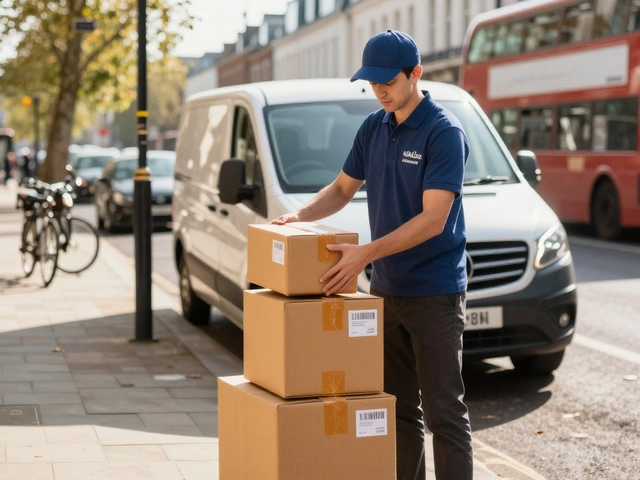If you’ve ever stood at the counter, a package in hand, wavering between DHL and USPS for that big international shipment, you’re not alone. I’ve been there, squinting at price charts and weighing how much cat food I could buy with the difference. Shipping internationally is tricky — you want it fast, you want it safe, but you’re not out here to drain your wallet on a single package. And unless you’re shipping gold bars or a dozen pineapples, every little cost makes a difference. So, is DHL cheaper than USPS International in 2025? The answer isn’t as clear-cut as their trackable lines, but let’s break it down to make choosing your shipping partner way less stressful.
Breaking Down DHL and USPS International Pricing
DHL and USPS have always danced around each other in the shipping world: DHL, the bold global courier with its yellow vans, and USPS, the local legend with international reach. Both promise to get your stuff across borders, but when you peek at the rates, things get spicy. Every year, both companies tweak their pricing – inflation, fuel surcharges, and new country agreements all shake up the numbers. In 2025, USPS has rolled out another small rate hike for its Priority Mail International and First-Class Package International services, blaming “global fuel market volatility” (their words, not mine). DHL, on their end, keeps carving up their service options, and while they’re usually pricier upfront, they pitch next-day capabilities and extra security perks.
Let’s toss numbers into the mix. Say you’re shipping a 2 lb box from New York to Berlin. As of July 2025, USPS First-Class Package International would ring up around $35, with a delivery window ranging from 9 to 15 days (give or take a customs holiday). Priority Mail International might creep closer to $60 for the same box, but arrival speeds up to 6-10 days, sometimes faster if you’re lucky. DHL Express, for that same box, will often throw back a quote in the $75 to $110 range. But get this: DHL usually puts your package in someone’s hands in Germany in just 2 to 4 days. You can see a pattern emerging—USPS wins on base price, especially on lighter parcels, but DHL shaves literal days off travel time while throwing in door-to-door tracking from end to end.
One sneaky fact: USPS actually hands off most of its international mail to the local postal carrier once your package hits a new country. DHL, as a private courier, delivers through its own global network (unless a particular country’s laws force them otherwise). This impacts everything from speed to reliability, but also factors into cost. DHL’s international shipping generally runs more expensive for almost every weight class. For one-pound shipments under 4 lbs, USPS almost always comes out cheaper, especially if you’re sending something with little urgency or value. Once you get into heavier or high-value packages, DHL’s shipping cost—though steeper—often includes better insurance and fewer potential headaches from customs hiccups.
I’ve seen people pay more for DHL without regret, simply because a missed deadline abroad could mean hundreds lost in business, or a super-important gift ruined by arriving way late. Others, like students mailing souvenirs back home, totally lean USPS for the best bang for their buck, waiting extra days without losing sleep. The balance tips depending on the sender’s needs, but dollars-and-cents, you’ll likely pay less with USPS if you’re willing to accept longer—and sometimes more unpredictable—delivery times.
Service Speed and Reliability: Why Fast Isn’t Cheap
If only international shipping was just about dollars! But time is money, right? DHL has carved out a reputation for rapid-fire delivery — think express, expedited, overnight, “your-package-has-barely-left-your-door-and-it’s-already-there” fast. They use their own network, managing their planes, vans, and customs clearance staff. This is a game-changer if speed is non-negotiable. Imagine you’re shipping legal documents, urgent prototypes, or rare collectibles across the Atlantic — those extra 40-50 bucks for DHL could save you missed deadlines and sleepless nights.
USPS does its best, but its international game relies on a whole patchwork of postal agencies. Once your package leaves the US, it joins the queue and rhythm of the recipient country’s postal system. I’ve had packages arrive in Tokyo within five days (yay, Japan’s efficient post!) and lost sight of Paris-bound boxes for weeks. USPS Tracking does what it can, but the moment your stuff leaves US borders, that handy tracker often says “In Transit” for days. DHL, in contrast, keeps you glued to your screen with real-time updates right down to the name of the person who signs for it. That extra transparency comes baked into the ticket price.
Here’s an odd little truth: reliability sometimes costs as much as speed. DHL’s insurance options, loss claims, and customer support tend to run circles around USPS, especially when a package gets stuck or—worst nightmare—goes missing. Even just making a claim with DHL feels less Kafkaesque than navigating USPS paperwork. On the other hand, for standard letters, low-value parcels, or non-urgent gifts, USPS international actually does a solid job most of the time. Just don’t ship perishable goods or items with a strict deadline through USPS if you value your peace of mind.
Here’s an inside tip for regular shippers: you can score better DHL rates if you use third-party shipping platforms. Those platforms negotiate bulk rates and often pass along the savings. It’s like group-buying discounted concert tix, but for your care packages. If you stick to USPS, always go through the “Click-N-Ship” online tool — sometimes it cuts a couple of dollars from what you’d pay in person, plus streamlines your customs forms. In 2025, with both companies pushing more digital platforms, these little hacks really add up.

Hidden Fees, Customs, and the Real “Cost” of Shipping
Let’s talk about those costs you don’t see right away—the ones that give you a minor heart attack when you check your bank statement. DHL is fast, yes, but did you know they may whack you (or your recipient) with handling fees, fuel surcharges, and sometimes “remote area” surcharges? Picture sending a package to a farm outside Copenhagen—they might tag on $20 just because their delivery driver has to, basically, deliver to a sheep. Meanwhile, for certain destinations, DHL provides customs clearance as part of the base rate—but if they pay duties on behalf of your recipient, expect to see a processing fee.
USPS can be sneaky, too. While their pricing looks lower upfront, some countries apply steep import duties, VAT, or collection fees on postal packages, and USPS does not front those charges. If you’re sending to Europe, for example, packages worth even $30 can sometimes trigger a “postal handling” fee or an import tax that your recipient must pay. I’ll never forget mailing my aunt a $50 sweater to Dublin: she had to cough up another €20 before the postman handed it over. USPS will not let you prepay duties, unlike DHL, which offers that “Delivered Duty Paid” (DDP) service if you want better predictability.
A big win for USPS: flat-rate boxes and envelopes. These are a game-changer if your thing is heavy-but-small goods (like books or spare parts). The price stays the same up to the weight limit, which sometimes beats everyone else’s quotes by a long shot—especially for far-flung or expensive-to-ship-to places. Just be aware, flat-rate can turn into “flat-slow” if you pick the cheapest USPS service. DHL almost never has a flat-rate equivalent, so if your parcel is dense, USPS can save you more than just lunch money.
Now, cats and customs have this in common: both love to get in the way. If your package contains risky goods (lithium batteries, liquids, perfumes), both DHL and USPS may refuse or whack on special fees. DHL’s system is more transparent and offers more guidance at the time of booking. USPS, meanwhile, expects you to decipher a labyrinth of restrictions and hope that customs doesn’t decide to play hide-and-seek with your box for a week.
Which Is Right for You? Real Scenarios
Here’s where it gets real: affordability depends on your priorities and the exact package specs. Are you sending a visa application or passport? Don’t gamble: DHL’s fast, guaranteed shipping and tracking is worth every extra dollar. Mailing a few t-shirts to friends in Paris? USPS Priority Mail International will get the job done for less, and your friends can wait. Selling on Etsy to customers abroad? It’s a toss-up—small, lightweight items ship cheapest with USPS, but if your handmade wares are pricey, DHL’s insurance could save your bacon if things go sideways.
For frequent shippers, loyalty programs and negotiated rates play a huge role. Businesses sometimes get better DHL rates if they hit shipping minimums (think over 20 parcels a month). USPS rarely budges on their public rates unless you’re a giant e-commerce seller using their bulk systems. Third-party shipping tools—like Pirate Ship or ShipStation—list both DHL and USPS quotes side by side, sometimes offering DHL eCommerce rates that bridge the gap between slow post and high-speed courier. In many cases, DHL eCommerce can be almost as affordable as USPS regular rates, but with far better tracking.
People often overlook local alternatives. In some countries, private courier partnerships, like DHL with local express firms, offer budget-friendly express rates. Ask at your post office or plug your details into online shipping comparison tools—sometimes a lesser-known partner sneaks in with a better deal. Also, if you’re shipping to countries with unreliable posts (looking at you, Brazil and Italy), DHL wins points for reliability regardless of price.
Finally, don’t forget about pickup and convenience. DHL can show up at your doorstep, label in hand, saving you a trip. USPS usually expects you to drop off, and while their post offices are everywhere, they’re not exactly the speediest experience. Time is money, especially if you’re juggling pets, jobs, and that ever-present laundry pile.

Tips for Saving Money on International Shipping in 2025
Alright, let’s talk hacks that can keep your wallet intact. First, always box smart. A compact, well-packed box usually beats a bigger one, since both DHL and USPS use weight and dimensions to calculate price. If your item fits in a flat-rate envelope and you don’t mind the delivery window, USPS is hard to beat for cost, especially for documents and small gifts.
Shedding ounces matters. Try to keep packaging as light as possible, especially for USPS First-Class Package International — every quarter pound can bump the rate. With DHL, keeping your parcel boxy and under standard measurements avoids “dimensional weight” upcharges, which can balloon fast for odd-shaped packages.
If you really need tracking and speed but don’t want the full DHL splurge, explore DHL eCommerce or USPS Priority Mail Express International. These mid-tier services land between the extremes of snail-mail slow and wallet-busting express courier. Don’t forget to compare rates online—third-party tools might unlock deals not advertised directly through carriers.
Don’t skip the fine print on insurance. USPS covers most international packages up to $200 (flat for Priority), but not for all countries or all types of losses. DHL insures almost every shipment up to $100 automatically, and you can buy higher limits. Sometimes what you save upfront isn’t worth the pain of lost goods and impossible claims.
One last pet peeve: customs forms. Both USPS and DHL require detailed forms for international shipments. Filling these out online isn’t just easier—it’s faster and less prone to error. Incorrect forms are the top reason for delays, and nobody wants their birthday gift sitting in a customs warehouse until Halloween.
Shipping internationally isn’t just about choosing the cheapest service. It’s finding the sweet spot between cost, speed, and how much you really care about your package’s journey. Next time you find yourself at that shipping counter, take a deep breath, weigh your options, peek at online comparison tools (some even fetch you live rates geotagged to your zip code in 2025), and ship smarter. And say hi to the front-desk cat, if your post office is as cozy as mine.





